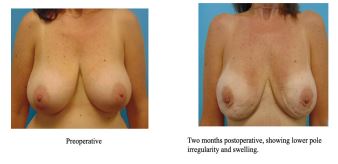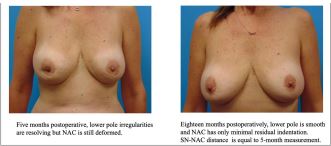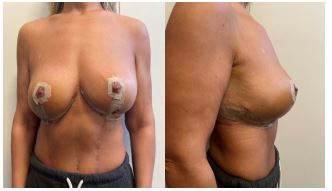Thank you for this opportunity to comment on the above paper, which I published jointly with Jeffrey Marvel MD, four years ago. I particularly appreciate the opportunity to comment on this publication because both Dr. Marvel (the paper’s senior author) and I have essentially ceased offering this procedure despite the benefits described in the original publication (which include reduced scarring, reduced operative complexity, lower complication rate, reduced surgical time), due – as seen below – to patient preference.
As described below, I now perform mastopexy exclusively in what that article terms the “excisional technique” because I am able to provide more rapid, as well as more dramatic and “complete” cosmetic results using these techniques than using the technique described in the article. Furthermore, I discovered subsequent to publishing the original article that the majority of patients who seek cosmetic breast lifting (as opposed to those whose primary goal is the alleviation of physical symptoms of hypermastia through a breast reduction procedure), when fully informed of the prolonged recovery period and possible asymmetries associated with laser-assisted liposuction-only mastopexy, will opt for an excisional procedure, despite those procedures’ visible scarring and greater complication rates. Ultimately, I believe that the procedure as described in the original paper is sound. However, both the senior author and I underestimated the fundamental differences in patient expectations regarding mastopexy, a cosmetic procedure, and breast reduction, a reconstructive procedure which almost always includes a mastopexy as a fundamental aspect of its completion.
The first documented breast reduction surgery was performed in 1895 by French surgeon Charles Dujarier. Reduction mammaplasty involves removing excess skin, fat, and tissue from the breasts to reduce their size, as well as reshape the skin envelope of the glands. The surgical goals include: achieving a more aesthetically pleasing and proportionate breast size, as well as alleviating physical discomfort or functional problems caused by large breasts. Breast lift surgery, also known as mastopexy, involves reshaping and lifting the breasts to a more youthful and aesthetically pleasing position. The first documented breast lift surgery also was performed in the late 19th century. However, the technique used in the early breast lift procedures was quite different from the procedures used today. The first breast lift surgery involved the removal of a crescent-shaped piece of skin from the lower portion of the breast, which made it appear that the nipple and areola had been lifted to a higher apparent position relative to the breast meridian. Today, breast lift surgery involves the use of various techniques and incision patterns to lift the nipple-areolar complex and to reshape the breasts. At least one hundred thousand women underwent breast reduction or mastopexy in the United States in 2020, according to the American Society of Aesthetic Plastic Surgery.
Breast reduction using liposuction as an adjunct has been in widespread use since the 1990s, and in the early 2000s Moskovitz et al published a large prospective trial of liposuction-only breast reduction surgery, following up on other publications regarding this surgical technique in the US literature which were not based on prospectively-selected patient cohorts. The Moskovitz study demonstrated a low complication rate and excellent alleviation of symptoms, using standardized and previously validated patient questionnaires which showed a significant decrease in breast-related symptoms, a significant decrease in patient pain, and a significant improvement in overall patient health perception. Unfortunately, however, in the United States, most insurance companies refuse to compensate surgeons and surgery centers for any use at all of liposuction during breast reduction surgery.
Although liposuction has been accepted for two decades - either alone or conjunctively with excisional surgery – as a safe and effective means of performing breast reduction, it never has gained general acceptance in breast lift surgery. This lack of acceptance likely is because the primary problem being addressed in breast lifting is loose skin, the tightening of which is not a primary benefit of liposuction surgery. However, in the late 1990s and the early 2000s - with the advent, respectively, of ultrasound-assisted and laser-assisted liposuction – many surgeons have sought to incorporate the intrinsic skin-tightening properties of subcutaneously-delivered energy in abdominal and breast procedures. Our study appeared to be the first to look specifically at the use of laser energy as a skin-tightening adjunct to volume reduction using liposuction only in mastopexy.
Although our small study did result in high patient satisfaction, no complications, and a high correlation of upward nipple movement when comparing one side to the other, ultimately, I discovered that patients undergoing this cosmetic breast procedure suffered some second thoughts about having undergone the procedure during their prolonged healing period.
Below are preoperative and postoperative photographs of a 48-year-old patient who had an excellent final result after having undergone a 500cc glandular resection bilaterally, ultimately resulting in a smooth lower breast contour and only a 4mm difference in sternal notch to nipple position (the patient’s right side was 4mm lower than her left).


The preceding patient has no visible scarring and achieved a symmetrical and aesthetically pleasing lifting of her nipple-areolar complex as well as an aesthetically pleasing lower pole contour. However, as alluded to above, when patients are fully informed of the prolonged postoperative swelling and skin irregularities, they almost always choose either to forego surgery or to proceed with excisional surgery. Below are preoperative and 5 day postoperative photographs of a patient who was seen in my office earlier today for her first postoperative visit (her steri-strips are still in place). She underwent a weight loss of more than half of her body weight, has had abdominal and posterior body contouring, and will have implants placed approximately two months from now to improve her upper pole fullness. In contrast with the laser-assisted liposuction breast lift patient whose photographs are immediately above, this patient has minimal swelling and can already see her postoperative appearance less than one week after surgery.


While both the initial article’s senior author and I were quite pleased with the results obtained by performing laser-assisted breast lifting procedures, we likely were not looking at this cosmetic procedure through the eyes of cosmetic surgery patients. He and I seem to have fallen into a trap that is to some degree the converse of hyperbolically discounting – we were focused almost entirely on the long-term results rather than seeing through our patients’ eyes. In doing so, we may have underestimated the importance of this “routine” procedure to our patients and unconsciously may have treated a cosmetic procedure as a reconstructive one (especially in that we seem to have grossly misjudged the importance of an immediate result for our patients). Although from a surgeon’s perspective laser-assisted liposuction-only mastopexy does provide symmetrical and cosmetically pleasing results with no visible scars and no complications (in our series), from the patient’s perspective these results do not appear to be worth the prolonged recovery period. As such, neither the paper’s senior author nor I currently perform the procedure as described in our earlier article.
For an interesting discussion of the importance of an even more “routine” procedure on patients’ psyche, I recommend Wojtkowska A, Zaborski D, Modrzejewski A, Pastucha M. The effect of cosmetic surgery on mental self-image and life satisfaction in women undergoing breast augmentation: An intermediate role of evaluating the surgery as one of the most important life events. J Plast Reconstr Aesthet Surg. 2022 Jun;75(6):1842-1848.
None.
None.
I no potential conflicts of interest with respect to the research, authorship, and/or publication of this article. The authors have no financial conflict of interest to report, including, but not limited to, no employment, consultancies, stock ownership, honoraria, paid expert testimony, patent applications/registrations, and grants or other funding from the manufacturers of the 2 devices (or any similar devices) mentioned in the original article.

